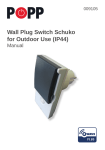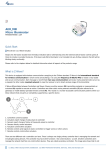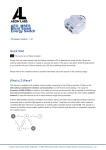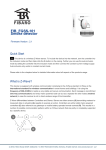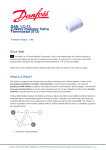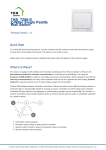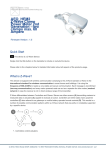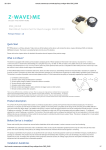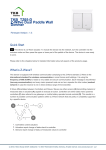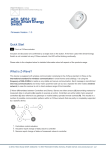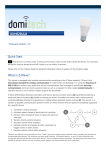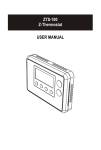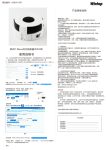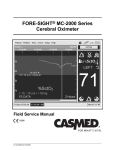Download EVR_SE812 Z-Wave Siren - smart
Transcript
EVR_SE812 Z-Wave Siren Firmware Version : 0.0 Quick Start A This device is a Z-Wave actor. For Inclusion and Exclusion push the Inclusion/Exclusion Switch behind the rear cover quickly 3 times. Please refer to the chapters below for detailed information about all aspects of the products usage. What is Z-Wave? This device is equipped with wireless communication complying to the Z-Wave standard. Z-Wave is the international standard for wireless communication in smart homes and buildings. It is using the frequency of 868.42 MHz to realize a very stable and secure communication. Each message is reconfirmed (two-way communication) and every mains powered node can act as a repeater for other nodes (meshed network) in case the receiver is not in direct wireless range of the transmitter. Z-Wave differentiates between Controllers and Slaves. Slaves are either sensors (S) transmitting metered or measured data or actuators (A) capable to execute an action. Controllers are either static mains powered controllers (C) also referred to as gateways or mobile battery operated remote controls (R). This results in a number of possible communication patterns within a Z-Wave network that are partly or completely supported by a specific device. 1. Controllers control actuators 2. Actuators report change of status back to controller 3. Sensors report change of status of measured values to controller (c) 2012 Z-Wave Europe GmbH, Goldbachstr. 13, 09337 Hohenstein-Ernstthal, Germany, All rights reserved, www.zwaveeurope.com - pp 1 4. 5. 6. 7. Sensors directly control actuators Actuators control other actuators Remote controls send signals to static controllers to trigger scenes or other actions Remote controls control other actuators. There are two different role a controller can have. There is always one single primary controller that is managing the network and including/excluding devices. The controller may have other functions - like control buttons - as well. All other controllers don't manage the network itself but can control other devices. They are called secondary controllers. The image also shows that its not possible to operate a sensor just from a remote control. Sensors only communicate with static controllers. Product description The Siren SE812 Siren will warn everybody in the building by a loud sound and a flashing light about an alarm. This product is especially suited to use in combination with other Z-Wave devices such as sensors. The SE812 Siren gives a loud sound and a flashing warning light, so everybody in the building will know immediately that an alarm has occurred. You can choose to activate the siren either by burglary alarm or by a smoke alarm or activate the siren by both alarms. It is even possible to install multiple sirens, so the alarm can be heard loudly at multiple locations. The SE812 Siren has an adjustable jumper inside, so you can choose between either a 90dB or a 100 dB volume of the siren. Choose either the included batteries or a power supply to power your siren. When using batteries, the siren will give a warning when the batteries are almost empty. Before Device is installed Please read carefully the enclosed user manual before installation of the radio-actuator, in order to ensure an error-free functioning. ATTENTION: only authorized technicians under consideration of the country-specific installation guidelines/norms may do works with 230?Volt mains power. Prior to the assembly of the product, the voltage network has to be switched off and ensured against re-switching. The product is permitted only for proper use as specified in the user manual. Any kind of guarantee claim has to be forfeited if changes, modifications or painting are undertaken. The product must be checked for damages immediately after unpacking. In the case of damages, the product must not be operated in any case. If a danger-free operation of the equipment cannot be assured, the voltage supply has to be interrupted immediately and the equipment has to be protected from unintended operation. Installation Guidelines 1. Undo and remove the fixing screws from the bottom edge of the Indoor Siren and remove the rear cover. 2. Insert four LR14 1.5V size alkaline batteries to the battery compartment, ensuring correct polarity. (c) 2012 Z-Wave Europe GmbH, Goldbachstr. 13, 09337 Hohenstein-Ernstthal, Germany, All rights reserved, www.zwaveeurope.com - pp 2 3. You can use power adapter instead of batteries. The power adapter is an optional accessory. A cable track is set inside the unit for you to secure the power adapter. To install the power adapter, connect the plug of power adapter to the DC jack inside the unit. Route the cable along the cable track. 4. There are two jumpers on the backside to set sound level and tamper switch. With the upper jumper the sound level can be set to 90db or 100db. With the lower jumper the tamper switch can be enabled or disabled. (c) 2012 Z-Wave Europe GmbH, Goldbachstr. 13, 09337 Hohenstein-Ernstthal, Germany, All rights reserved, www.zwaveeurope.com - pp 3 5. Use the rear cover as a mounting plate, mark the positions of the three fixing holes on the wall. Fasten the rear cover to the wall using the screws and wall plugs provided. (c) 2012 Z-Wave Europe GmbH, Goldbachstr. 13, 09337 Hohenstein-Ernstthal, Germany, All rights reserved, www.zwaveeurope.com - pp 4 Behavior within the Z-Wave network I On factory default the device does not belong to any Z-Wave network. The device needs to join an existing wireless network to communicate with the devices of this network. This process is called Inclusion. Devices can also leave a network. This process is called Exclusion. Both processes are initiated by the primary controller of the Z-Wave network. This controller will be turned into exclusion respective inclusion mode. Please refer to your primary controllers manual on how to turn your controller into inclusion or exclusion mode. Only if the primary controller is in inclusion or exclusion mode, this device can join or leave the network. Leaving the network - i.e. being excluded - sets the device back to factory default. If the device already belongs to a network, follow the exclusion process before including it in your network. Otherwise inclusion of this device will fail. If the controller being included was a primary controller, it has to be reset first. When the device is first time powered up it is not included in a Z-Wave network and has no Associations. The Siren will stay "awake" for 10 minutes when power is first applied to allow the configuration. 1. Inclusion: For Inclusion bring your Z-Wave controller in the relevant mode and click the inclusion/exclusion switch quickly 3 times. The green LED is on and the siren beeps when the switch is pressed. (c) 2012 Z-Wave Europe GmbH, Goldbachstr. 13, 09337 Hohenstein-Ernstthal, Germany, All rights reserved, www.zwaveeurope.com - pp 5 2. Exclusion: For Exclusion bring your Z-Wave controller in the relevant mode and click the inclusion/exclusion switch quickly 3 times. The green LED is on and the siren beeps when the switch is pressed. 3. Reset: For Resetting click the inclusion/exclusion switch quickly 3 times to bring the device in the reset mode. Within 1 second, press the switch again for 5 seconds until LED is off. The device now has factory settings. The orange LED is off and the siren beeps for 5 seconds. 4. Association: For Association bring your Z-Wave controller in the relevant mode and click the inclusion/exclusion switch quickly 3 times to bring it in the association mode. The device supports one association group with 5 nodes for Grouping 1. Operating the device Self-Protection Mode: Once the device is closed for three seconds and the tamper switch is activated it will give an alarm for 3 minutes, if it is violent opened or manipulated. When the siren is in the normal mode and an associated device triggers an alarm the siren and the flash light will be activated. Wakeup Intervals - how to communicate with the device? W This device is battery operated and turned into deep sleep state most of the time to save battery life time. Communication with the device is limited. In order to communicate with the device, a static controller C is needed in the network. This controller will maintain a mailbox for the battery operated devices and store commands that can not be received during deep sleep state. Without such a controller, communication may become impossible and/or the battery life time is significantly decreased. This device will wakeup regularly and announce the wakeup state by sending out a so called Wakeup Notification. The controller can then empty the mailbox. Therefore, the device needs to be configured with the desired wakeup interval and the node ID of the controller. If the device was included by a static controller this controller will usually perform all necessary configurations. The wakeup interval is a tradeoff between maximal battery life time and the desired responses of the device. Tripple click on the inclusion/exclusion switch or a detected action by the sensor will wake up the device and keep it awake. It is possible to set the node ID to 255 to send wakeup notifications as broadcast. In this mode device takes more time to go to sleep and drains battery faster, but can notify all it's direct neighbors about a wakeup. Command Classes Supported Command Classes Alarm (version 1) Association (version 2) Basic (version 1) Battery (version 1) (c) 2012 Z-Wave Europe GmbH, Goldbachstr. 13, 09337 Hohenstein-Ernstthal, Germany, All rights reserved, www.zwaveeurope.com - pp 6 Binary Switch (version 1) Manufacturer Specific (version 1) Version (version 1) Technical Data Explorer Frame Support No SDK 5.02 pl2 Device Type Slave with routing capabilities Generic Device Class Binary Switch Specific Device Class Specific Device Class not used Routing No FLiRS No Firmware Version 0.0 Explanation of Z-Wave specific terms Controller — is a Z-Wave device with capabilities to manage the network. Controllers are typically Gateways, Remote Controls or battery operated wall controllers. Slave — is a Z-Wave device without capabilities to manage the network. Slaves can be sensors, actuators and even remote controls. Primary Controller — is the central organizer of the network. It must be a controller. There can be only one primary controller in a Z-Wave network. Inclusion — is the process of bringing new Z-Wave devices into a network. Exclusion — is the process of removing Z-Wave devices from the network. Association — is a control relationship between a controlling device and a controlled device. Wakeup Notification — is a special wireless message issued by a Z-Wave device to annonces that is is able to communicate. Node Information Frame — is a special wireless message issued by a Z_Wave device to announce its capabilities and functions. Disposal Guidelines The product does not contain hazardous chemicals. Do not dispose of electrical appliances as unsorted municipal waste, use separate collection facilities. Contact your local government for information regarding the collection systems available. If electrical appliances are disposed of in landfills or dumps, hazardous substances can leak into the groundwater and get into the food chain, damaging your health and well-being. (c) 2012 Z-Wave Europe GmbH, Goldbachstr. 13, 09337 Hohenstein-Ernstthal, Germany, All rights reserved, www.zwaveeurope.com - pp 7








